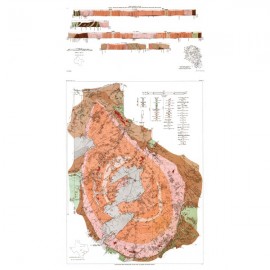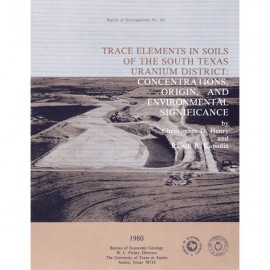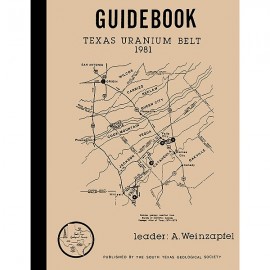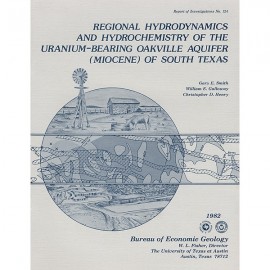Reports of Investigations
-
Books & Reports
- Reports of Investigations
- Guidebooks
- Udden Series
- Geological Circulars
- Down To Earth
- Atlases of Major Oil and Gas Reservoirs
- Texas Memorial Museum Publications
- Environmental Geologic Atlas of the Texas Coastal Zone
- Mineral Resource Circulars
- Other Reports
- Seminars and Workshops
- Handbooks
- Submerged Lands of Texas
- Symposia
- Annual Reports
- Open File Reports
-
Maps & Cross Sections
- Thematic Maps
- Miscellaneous Maps, Charts & Sections
- Geologic Atlas of Texas
- STATEMAP Project Maps
- Geologic Quadrangle Maps
- Cross Sections
- Highway Geology Map
- Energy and Mineral Resource Maps
- Shoreline Change and Other Posters
- Wilcox Group, East Texas, Geological / Hydrological Folios
- Bouguer Gravity Atlas of Texas
- River Basin Regional Studies
- Featured Maps
- Posters
- Teachers & the Public
-
Geological Society Publications
- Gulf Coast Association of Geological Societies
- Alabama Geological Society
- Austin Geological Society
- Corpus Christi Geological Society
- Houston Geological Society
- Lafayette Geological Society
- Mississippi Geological Society
- New Orleans Geological Society
- South Texas Geological Society
- GCS SEPM Publications
- Historic BEG & UT Series
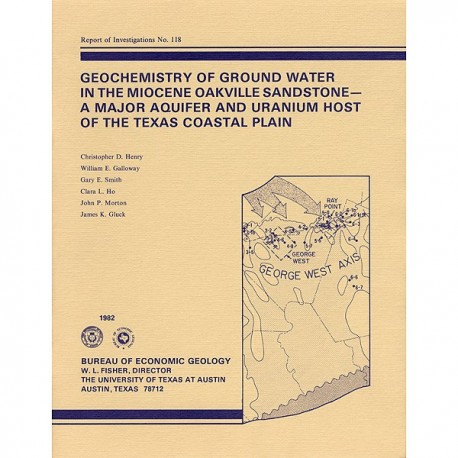
Geochemistry of Ground Water in the Miocene Oakville Sandstone...Texas Coastal Plain
RI0118
Geochemistry of Ground Water in the Miocene Oakville Sandstone--A Major Aquifer and Uranium Host of the Texas Coastal Plain, by C. D. Henry, W. E. Galloway, G. E. Smith, C. L. Ho, J. P. Morton, and J. K. Gluck. 63 p., 21 figs., 9 tables, 3 appendices, 1982. ISSN: 0082335X:Print. Print Version.
A free, digital version of this publication can be found on: Texas ScholarWorks
RI0118. Geochemistry of Ground Water in the Miocene Oakville Sandstone--A Major Aquifer and Uranium Host of the Texas Coastal Plain, by C. D. Henry, W. E. Galloway, G. E. Smith, C. L. Ho, J. P. Morton, and J. K. Gluck. 63 p., 21 figs., 9 tables, 3 appendices, 1982. ISSN: 0082335X:Print.
To purchase this publication as a downloadable PDF, please order RI0118D.
ABSTRACT
The Oakville Sandstone is a major aquifer and a major host of uranium deposits in the Texas Coastal Plain. This report discusses the geochemistry - including major ions, the trace elements uranium, molybdenum, arsenic, and selenium, and oxidation-reduction potential – of Oakville ground water to evaluate the potential effect of uranium mining on water quality. Ground-water chemistry was investigated both regionally and in two major uranium mining districts.
Major ion composition of Oakville ground water shows a regional variation. East Texas water has low to moderate dissolved solids (350 to 1,100 mg/L) and evolves from a calcium-magnesium-bicarbonate water in near-surface recharge areas to a sodium-bicarbonate composition downdip. The composition and evolution result from calcite solution and cation exchange. South Texas water has higher dissolved solids (up to 3,000 mg/ L) dominated by sodium, chloride, and sulfate. The high dissolved solids result from solution of evaporites within the Oakville and from the discharge along faults into the Oakville of high-dissolved-solids water from deeper aquifers.
There are three oxidation-reduction zones within the Oakville: (1) an oxidizing zone with Eh values greater than 300 mV, controlled by the presence of measurable concentrations of dissolved oxygen, (2) an intermediate zone with Eh values between 110 and 10 mV, probably controlled by ferrous-ferric mineral reactions, and (3) a reducing zone with Eh values less than -40 mV, probably controlled by the presence of FeS2.
Uranium, molybdenum, arsenic, and selenium show regional variations in concentrations, with trace element values in South Texas water distinctly higher than in East Texas water. The higher concentrations may result either from secondary dispersion from uranium deposits, which are more abundant in South Texas than in East Texas, or from a residual primary source in South Texas. Uranium closely follows behavior predicted from thermodynamic data; equilibrium with coffinite determines uranium concentrations in intermediate-Eh and reducing water. The other three elements do not follow predicted behavior, probably because no data are available on complexing.
Analysis of water chemistry around the two uranium mining districts gives results similar to those found in the regional study. Very high concentrations of trace elements occur only in a few samples within ore zones. These high concentrations probably result from natural dispersal from the deposits, although this is not a widespread phenomenon.
Keywords: Oakville, water chemistry, uranium, aquifers, geochemistry, Texas, East Texas
CONTENTS
ABSTRACT
INTRODUCTION
GEOLOGY OF THE OAKVILLE SANDSTONE
OAKVILLE GROUND-WATER SAMPLING PROGRAM
MODELING OF GROUND-WATER CHEMISTRY
REGIONAL WATER CHEMISTRY
MAJOR ION CHEMISTRY
East Texas
South Texas
OXIDATION AND REDUCTION
Oxidizing zone
Intermediate Eh zone
Reducing zone
Summary of oxidation-reduction patterns
DISTRIBUTION OF TRACE ELEMENTS
Precipitation
Uranium
Molybdenum
Selenium.
Arsenic
Conclusion
Implications of regional distribution
Uranium
Selenium
Molybdenum
Arsenic
WATER CHEMISTRY IN URANIUM DISTRICTS
RAY POINT DISTRICT.
Major ion chemistry
Oxidation-reduction
Trace element concentrations
GEORGE WEST DISTRICT
Major ion chemistry
Oxidation-reduction
Trace element concentrations
CONCLUSIONS
EVALUATION OF GEOCHEMICAL CONTROLS OF TRACE ELEMENT CONCENTRATIONS
EH GRADIENTS
ACKNOWLEDGMENTS
REFERENCES
APPENDICES
A. ANALYTICAL DATA
A-1. Regional samples
A-2. Ray Point area samples
A-3. George West area samples
B. WELL CROSS SECTIONS
C. PROCEDURES FOR ANALYSIS OF ARSENIC, MOLYBDENUM, SELENIUM, AND URANIUM IN WATER
FIGURES
1. Depositional elements of the Oakville fluvial system
2. Generalized distribution of faults and diapiric intrusions
3. Piper (trilinear) diagram: Oakville ground water
4. Eh-pH diagram showing hypothesized controls on the oxidation-reduction state of Oakville water
5. Plot of coffinite saturation indices versus dissolved H2S, in ppm, for selected Oakville water samples
6. Eh-pH diagrams for uranium species at 25° C, 1 atm
7. Eh-pH diagrams for molybdenum species at 25° C, 1 atm
8. Eh-pH diagrams for selenium species at 25° C, 1 atm
9. Eh-pH diagram for arsenic species at 25° C, 1 atm
10. Adsorption characteristics of uranium, molybdenum, selenium, and arsenic
11. Ray Point area, South Texas, showing sampling locations, Oakville net sand, and areas of mining
12. Cross sections of Ray Point district, Texas, showing water wells sampled for this study
13. Piper (trilinear) diagram: water of the Ray Point district, Texas
14. Distribution of Eh values and concentrations of dissolved O2 and H2S in water of the Ray Point district, Texas
15. George West area, South Texas, showing sampling locations, Oakville net sand, and areas of mining
16. Cross sections of the George West district, Texas, showing water wells sampled for this study
17. Piper (trilinear) diagram: water of the George West district, Texas
18. Distribution of Eh values and concentrations of dissolved 02 and H2S in water of the George West district, Texas
19. Distribution of arsenic concentrations in water of the George West district, Texas
20. Distribution of molybdenum concentrations in water of the George West district, Texas
21. Distribution of uranium concentrations in water of the George West district, Texas
TABLES
1. Saturation indices for major element minerals (regional wells)
2. Measured and calculated Eh, dissolved 02, and H2S (regional wells)
3. Saturation indices for trace element minerals (regional wells)
4. Saturation indices for major element minerals (Ray Point wells)
5. Measured and calculated Eh, dissolved O2, and H2S (Ray Point wells)
6. Saturation indices for trace element minerals (Ray Point wells)
7. Saturation indices for major element minerals (George West wells)
8. Measured and calculated Eh and dissolved O2, and H2S (George West wells)
9. Saturation indices for trace element minerals (George West wells)
Citation
Henry, C. D., Galloway, W. E., Smith, G. E., Ho, C. L., Morton, J. P., and Gluck, J. K., 1982, Geochemistry of Ground Water in the Miocene Oakville Sandstone--A Major Aquifer and Uranium Host of the Texas Coastal Plain: The University of Texas at Austin, Bureau of Economic Geology, Report of Investigations No. 118, 63 p.

